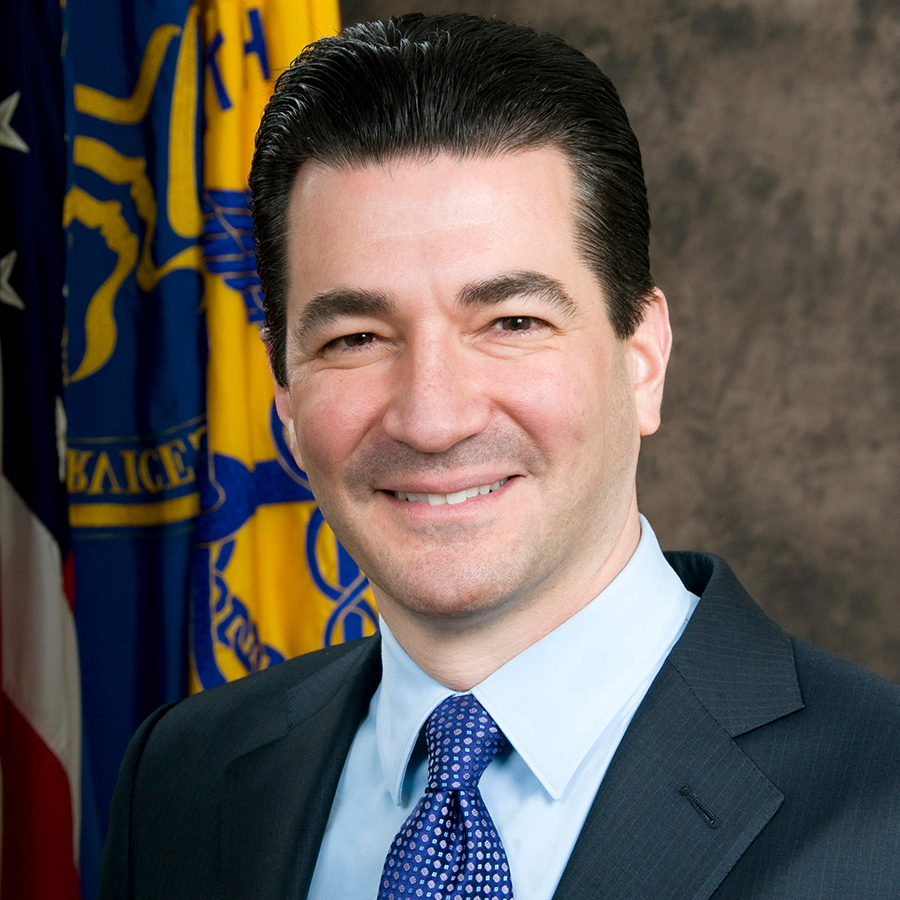FDA Proposes New Steps to Advance Clinical Testing to Deliver New Cures
By: Scott Gottlieb, M.D., FDA Commissioner, Jeff Shuren, M.D., J.D., CDRH Director, and Lauren Silvis, J.D., FDA Chief of Staff
This year, we’re seeing an unprecedented rate of approvals of more targeted medicines. We’ve already broken some prior benchmarks for new drug approvals and are on pace to set some new records. One reason is because more diseases are being redefined based on their molecular subtype, providing more novel targets and more openings to intervene on the biological drivers of illness. As researchers unlock the molecular basis of disease, they are creating new opportunities to treat patients in more precise ways, and at different points in the trajectory of an illness. Importantly, they are developing drugs that show outsized benefits for patients.
Just a decade ago, some in the medical community lamented that we weren’t seeing a public health payoff from our public and private investments in genomics, proteomics and the mapping of the human genome. But today, we’re seeing the fruits of our research and capital in the form of more impactful, and often precision-guided drug approvals that are providing meaningful benefits to patients. And biomarker-enriched clinical trials are helping enable these opportunities. They allow us to hone in on important safety and efficacy signals in targeted populations earlier in the clinical development process, and deliver more effective treatments to patients more quickly, while maintaining the agency’s gold standard for approval.
These kinds of paradigm changes in medicine are often the result of synergistic advances in both basic science and applied technology. Fifteen or twenty years ago, peering through a microscope was still the primary way pathologists diagnosed and characterized cancers. Today, new genetic and genomic tests are allowing us to “see” human genomics at work in complex illnesses like cancer. Along the way, we’re leveraging this insight to redefine medicine — from classifying diseases based on organ systems and clinical symptoms to mechanistic definitions of disorders based on shared molecular pathways.
The advent of new technologies for detecting genetic variants related to cancer has transformed our understanding of the disease from one based on histology — how the cell or tissue looks — to how it functions at the genomic level. Today, we have FDA-authorized next generation sequencing tests that can be used to sequence hundreds of genes to identify thousands of variants from any solid tumor, including rare cancers.
Tests like these have helped us redefine lung cancer from just two large subtypes to dozens of rare diseases, like ALK, EGFR, MET, ROS1, BRAF, NTRK, and many others. Individually, these genetic variants may only account for 1-2 percent of patients with lung adenocarcinomas. But collectively, variants in these genes account for more than 50 percent of lung cancers. This allows patients to receive more targeted and specialized treatments that can also be more effective. And more complex definitions of the disease, based on panels of biomarkers, may be on the way as well.
For patients who are suffering from cancer, this innovation has the potential to dramatically improve outcomes. Diagnostics are the technology enabling the development and delivery of the new and more targeted medicines that make the identification of the underlying targets possible. These diagnostics help identify the disease subsets and structure clinical trials based on these markets. They are also translating to changes in the clinic when it comes to how medicine is practiced. To take one example, this year FDA authorized a highly sensitive next generation sequencing (NGS)-based test for minimal residual disease (MRD) detection in patients with acute lymphoblastic leukemia (ALL) or multiple myeloma. Determining whether a patient has residual cancer cells remaining after treatment helps doctors evaluate how well a patient has responded to therapy and how long remission may last. Such innovative tests empower doctors and patients with better information to make treatment decisions.
Advances in diagnostic technology stretch well beyond oncology. Innovation is improving our ability to identify and treat infectious diseases and devastating hereditary and rare conditions. Within the last year, FDA authorized the first tests direct from specimens for Coccidioides, a fungus that causes the serious lung infection known as Valley Fever that’s often misdiagnosed; and the emerging pathogen Candidaauris, which can cause serious, often multidrug resistant bloodstream infections in hospitalized patients.
These developments are extremely promising. To fully realize these benefits, it’s critical that we continue to advance a modern framework for the development of advanced diagnostics — one that helps harness the full potential of new diagnostics to drive better treatment decisions with both current and future therapies, while also ensuring that such diagnostic tests are safe and effective.
But the ongoing success of these important public health efforts is uncertain. New tests that undergo rigorous FDA review must demonstrate that they’re analytically and clinically valid. But the majority of laboratory developed tests (LDTs) currently don’t demonstrate to FDA that they meet the same standards.
This lack of standardization between FDA-reviewed tests and LDTs with respect to the demonstration of analytical validation and clinical evidence needed before a test is offered to patients is concerning considering the critical role diagnostics play in advancing our ability to discover and develop new cures for disease and advance the proper use of new drugs patients.There’s also a striking lack of transparency about the performance of the laboratory tests that are being used today to drive treatment decisions.
The current paradigm for clinical testing leads to questions about the accuracy and reliability of certain diagnostic tests. The disparity can create disincentives for manufacturers to invest in the development of innovative tests that meet FDA’s standard of evidence for clinical validity when they have to compete with LDTs that aren’t being FDA-reviewed. It inhibits coverage decisions by payors. It’s generating increasing uncertainty in the marketplace. And ultimately, it could limit patient access to effective treatments.
In addition, tests that don’t demonstrate analytical and clinical validity, or are poorly designed, can expose patients to serious risks. Patients can be subjected to invasive testing or treatments they don’t need, or delay or forgo further testing or treatment altogether when they need it. For example, FDA has warned doctors and patients not to use screening tests for ovarian cancer because they have a high number of false results. These tests are especially problematic when they provide false negative results and are used by women with an increased risk for ovarian cancer due to family history or certain gene mutations. Currently, there’s no evidence to support that there’s an effective test to screen for ovarian cancer.
The marked discrepancy in the scientific review of clinical testing in America doesn’t make sense for doctors, patients, innovators, or payors. We know how we got here — FDA historically exercised enforcement discretion over most LDTs. But today, we need a unified approach to the regulation of in vitro clinical tests to protect patient safety, support innovation, and keep pace with the rapidly evolving technology that’s helping us find new treatments for disease. Patients rely on diagnostic test information to make decisions about their health regardless of who develops the test or where it comes from. We shouldn’t subject similar tests to different approaches just because they are made by different developers.
FDA supports a new approach that would:
- focus our review resources where they would make the most difference and where the risk is highest;
- provide strong postmarket authorities to protect patients from harm;
- require transparency about test performance and limitations;
- complement rather than duplicate laboratory certifications;
- incorporate third party review and inspection; and
- include a pathway for earlier patient access to breakthrough technologies.
We’ve shared these ideas widely, with Congress, patient groups, providers, professional societies, and test developers. We appreciate the time and attention Congress has devoted to the critical subject of diagnostics regulation and look forward to continuing to work with them on these issues.
Another meaningful feature of the new approach that the FDA is contemplating would be the more efficient allocation of the Agency’s review resources. We believe that eventually, with the right framework in place, only a small subset of tests — around 10 percent — would need individual premarket review. We’d concentrate individual premarket review on tests that are novel, higher risk, marketed directly to consumers, used at home, or cross-labeled for use with a drug or other therapeutic products.
Our review would focus on the analytical and clinical validity of those tests, as well as the unique issues that a test might present. This would include parameters such as whether a consumer can understand how to use the test properly, or whether there’s sufficient data to support claims on adjusting a specific dose of a drug based on the results of a test. We believe that an efficient review process would distinguish between those tests that are well-understood and those that present more complex scientific issues, that could also lead to more meaningful advances in patient care.
For about 40-50 percent of tests, we believe that a pre-certification type of program would be the right way to ensure analytical and clinical validity and protect patients from false or misleading test results, while promoting innovation. A pre-certification approach would allow the FDA to evaluate a developer and its ability to design and validate a test. The FDA could leverage this rigorous and targeted evaluation so that a review of each test itself would not be needed or could be streamlined.
Other tests, including manual, low risk, custom, low volume, rare disease, forensic, and public health surveillance, could be exempt from pre-market review, if coupled with appropriate provisions to allow FDA to take action against any problematic tests in order to protect patients from harm. Tests currently offered by clinical laboratories could be grandfathered, meaning they would not automatically need a review by FDA. These grandfathered tests would be reviewed only under certain circumstances, such as if they were significantly changed or if a safety issue was identified. But even with tests currently offered by labs, the FDA must be able to take appropriate action against problematic tests.
Transparency is a critical component of FDA’s proposed path forward. It’s remarkable to think that in 2018 we don’t know the full universe of tests that drive our healthcare decisions and contribute to costs throughout the system. All stakeholders should have access to information about test developer offerings, performance, claims, regulatory status (e.g., reviewed, pre-certified, exempt), and adverse events associated with each test. But patients, especially, should be empowered with information about the tests they’re receiving and accurate information that affects their decisions about their own health.
Our ultimate goal is to help patients find effective new treatments and cures for illness. And to do that, we need to advance the opportunities offered by new validated diagnostic technologies.
Improvements in technology and medicine have deepened our understanding of the causes of disease and potential treatment options. We’re already seeing how the ability of new tests to identify subsets of disease is driving a transformation in medical care and drug development. It’s our goal to make sure that these highly encouraging trends in drug discovery and new approvals — and advances in the practice of medicine — expand in the coming years. They’re being driven by the power of new diagnostics. And to solidify this progress, we need to modernize the current regulatory framework for in vitro clinical tests.



